VERNAL EQUINOX 2023
These may be the UN climate panel's last words before we hit 1.5 C limit
IPCC says we'll likely exceed lower Paris target, but there's
still hope if we do these things
The UN's international science panel on climate change has released what is likely its final report before the world hits 1.5 C of warming, one of the temperature targets that countries aimed not to exceed when they signed the Paris Agreement on climate change in 2016.
"Humanity is on thin ice — and that ice is melting fast," United Nations Secretary-General Antonio Guterres said at Monday's release of the latest synthesis report from the Intergovernmental Panel on Climate Change. "Our world needs climate action on all fronts — everything, everywhere, all at once."
This is likely the last warning the Nobel Peace Prize-winning collection of scientists will be able to make about the 1.5 mark, because their next set of reports will likely come after Earth has either breached the mark or locked into exceeding it soon, several scientists, including report authors, told The Associated Press.
Here are the key messages from Guterres and the report.
Rich nations must eliminate coal by 2030 and gas-fired electricity by 2035
Stepping up his pleas for action on fossil fuels, Guterres not only called for "no new coal" but also for eliminating its use in rich countries by 2030 and poor countries by 2040. He urged carbon-free electricity generation in the developed world by 2035, meaning no gas-fired power plants, either.
That date is key because nations soon have to come up with goals for pollution reduction by 2035, according to the Paris climate agreement.
New target for emissions cuts by 2035
After contentious debate, the UN science panel calculated and reported that to stay under the warming limit set in Paris, the world needs to cut 60 per cent of its greenhouse gas emissions by 2035, compared with 2019, adding a new target not previously mentioned in the six reports issued since 2018.
Scientists say we'll probably hit 1.5 C. That's bad, but there's still hope
"The choices and actions implemented in this decade will have impacts for thousands of years," the report said, calling climate change "a threat to human well-being and planetary health."
"We are not on the right track, but it's not too late,'' said report co-author and water scientist Aditi Mukherji. "Our intention is really a message of hope, and not that of doomsday.''
With the world only a few tenths of a degree away from the globally accepted goal of limiting warming to 1.5 C (2.7 F) since pre-industrial times, scientists stressed a sense of urgency. The goal was adopted as part of the Paris climate agreement and the world has already warmed 1.1 C (2 F).
After 1.5 C, "the risks are starting to pile on," said report co-author Francis X. Johnson, a climate, land and policy scientist at the Stockholm Environment Institute. The report mentions "tipping points" around that temperature of species extinction, including coral reefs, irreversible melting of ice sheets and sea level rise on the order of several metres.
"The window is closing if emissions are not reduced as quickly as possible," Johnson said in an interview. "Scientists are rather alarmed."
"1.5 is a critical limit, particularly for small islands and mountain [communities], which depend on glaciers," said Mukherji, who's also the climate change impact platform director at the research institute CGIAR.
Many scientists, including at least three co-authors, said hitting 1.5 C is inevitable.
"We are pretty much locked into 1.5," said report co-author Malte Meinshausen, a climate scientist at the University of Melbourne in Australia. "There's very little way we will be able to avoid crossing 1.5 C sometime in the 2030s," but the big issue is whether the temperature keeps rising from there or stabilizes.
Scientists emphasize that the world, civilization or humanity won't end if and when Earth hits and passes the 1.5 degree mark.
Mukherji said "it's not as if it's a cliff that we all fall off." But an earlier IPCC report detailed how the harms — from coral reef extinction to Arctic sea ice absent summers to even nastier extreme weather — are much worse beyond 1.5 C of warming.
But 1.5 C may still be achievable
Guterres insisted "the 1.5-degree limit is achievable."
Science panel chief Hoesung Lee said so far, the world is far off course.
"This report confirms that if the current trends, current patterns of consumption and production continue, then ... the global average 1.5 degrees temperature increase will be seen sometime in this decade," Lee said.
However, he said scientists hope the solutions outlined in the report will stabilize the globe's temperature around 1.5 C.
Asked whether this would be the last report to describe ways in which 1.5 C can be achieved, Lee said it was impossible to predict what advances might be made that could keep that target alive.
"The possibility is still there," he said. "It depends upon — again I want to emphasize that — the political will to achieve that goal."
We need to plan for a future warmer than 1.5 C
"It is certainly prudent to be planning for a future that's warmer than 1.5 degrees," said IPCC report review editor Steven Rose, an economist at the Electric Power Research Institute in the United States.
If the world continues to use all the fossil fuel-powered infrastructure that either exists now or is being proposed, Earth will warm at least 2 C, the report said.
Poor countries need huge boost in climate funding
The report and the underlying discussions also touch on the disparity between rich nations, which caused much of the problem, and poorer countries that get hit harder by extreme weather.
WATCH | Cyclone Freddie leaves at least 200 dead in southeast Africa:
If the world is to achieve its climate goals, poorer countries need a "many-fold" increase in financial help to adapt to a warmer world and switch to non-polluting energy. Countries have made financial pledges and promises of a damage compensation fund.
If rich countries don't cut emissions quicker and better help victim nations adapt to future harms, "the world is relegating the least developed countries to poverty," said Madeline Diouf Sarr, chair of a coalition of the poorest nations.
What's not included in the report: latest data, instructions on what to do
Because the report is based on data from a few years ago, the calculations about fossil fuel projects already in the pipeline do not include the increase in coal and natural gas use after Russia's invasion of Ukraine, said report co-author Dipak Dasgupta, a climate economist at The Energy and Resources Institute in India. The report comes a week after the Biden administration in the United States approved the huge Willow oil-drilling project in Alaska, which could produce up to 180,000 barrels of oil a day.
The report offers hope if action is taken, using the word "opportunity" nine times in a 27-page summary. Though "opportunity" is overshadowed by 94 uses of the word "risk."
The head of the IPCC said the report contains "a message of hope in addition to those various scientific findings about the tremendous damages and also the losses that climate change has imposed on us and on the planet."
"There is a pathway that we can resolve these problems, and this report provides a comprehensive overview of what actions we can take to lead us into a much better, livable future," Lee told The Associated Press.
Lee was at pains to stress that it's not the panel's job to tell countries what they should or shouldn't do to cap global temperature rise at 1.5 C.
"It's up to each government to find the best solution," he said.
Activists also found seeds of inspiration in the reports.
"The findings of these reports can make us feel disheartened about the slow pace of emissions reductions, the limited transition to renewable energy and the growing, daily impact of the climate crisis on children," said youth climate activist Vanessa Nakate, a goodwill ambassador for UNICEF.
"But those children need us to read this report and take action, not lose hope."
IPCC report: Here’s how we can defuse the
‘ticking time bomb’ of climate change
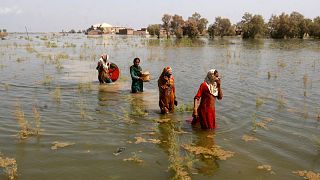
Pakistani women wade through floodwaters as they take refuge in Shikarpur district of Sindh Province, Pakistan. - Copyright AP Photo/Fareed Khan, File
By Rosie Frost • Updated: 20/03/2023 -
“If we act now, we can still secure a liveable, sustainable future for all,” Chair Hoesung Lee said at the launch of the latest Intergovernmental Panel on Climate Change (IPCC) report.
Written by the world’s leading climate experts, it lays out a clear path to drastically cut emissions and repair the damage that’s already been done. But it requires governments to get onboard and fund it - without delay.
This Synthesis Report brings together all the most up-to-date science on our warming planet.
It shows that, despite the unprecedented scale of the challenge, there are many solutions available to reduce greenhouse gas (GHG) emissions. Most importantly, they are available to us right now.
In 2018, the IPCC made the world aware of the unprecedented challenge of keeping global warming to 1.5°C. Five years later, it says that the challenge has become even bigger as GHG emissions have continued to rise.
The pace and scale of what has been done so far are insufficient to tackle climate change.
IPCC Chair Hoesung Lee adds that the Synthesis Report “underscores the urgency of taking more ambitious action”.
'Make no mistake, inaction and delays are not options': Latest IPCC report has been approved
1. We have no time left to waste
Scientists say that more than a century of burning fossil fuels as well as unequal land and energy use has led to global warming of 1.1°C. It has led to more frequent and intense extreme weather events that have impacted people around the world.
As the planet warms these hazards rapidly escalate. We see heavier rainfall, more intense heatwaves and other extreme weather.
“Humanity is on thin ice - and that ice is melting fast,” UN Secretary-General, António Guterres told a conference at the launch of the report.
He said that it details how humans are responsible for virtually all global heating over the last 200 years.
“The climate time bomb is ticking. But today’s IPCC report is a how-to guide to defuse the climate time bomb,” he said.
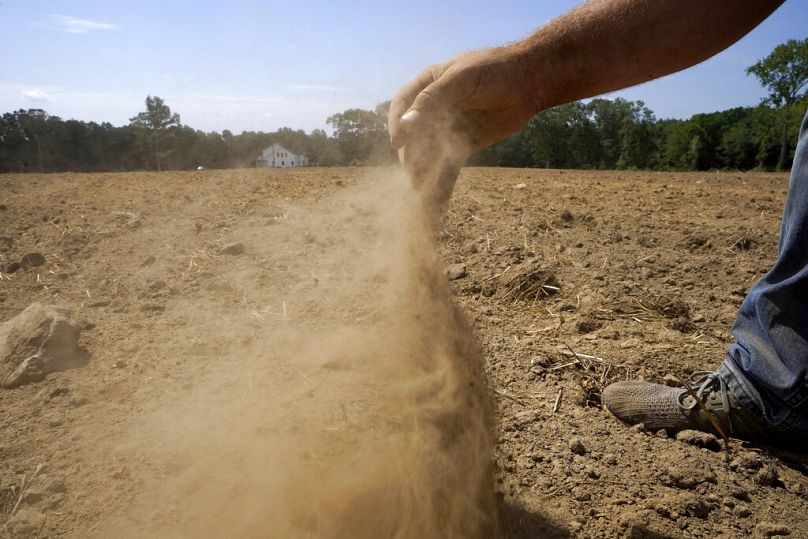
2. Countries that have emitted the least are feeling the impacts of climate change the most
The report also puts loss and damage in sharp focus. It says climate change will continue to hit the most vulnerable people and ecosystems especially hard.
Loss and damage refers to the negative consequences of climate change on human societies and the natural environment. It was an important topic at COP27 where a breakthrough agreement was made establishing a fund to address these consequences - particularly for vulnerable nations.
Climate justice is crucial because those who have contributed the least to climate change are being disproportionately affected.Aditi MukherjiOne of the Synthesis Report's authors
“Climate justice is crucial because those who have contributed the least to climate change are being disproportionately affected,” says Aditi Mukherji, one of the Synthesis Report’s 93 authors.
Tax the rich: A wealth tax could fund better transport and weather warning systems, report finds
She adds that almost half of the world’s population lives in regions that are highly vulnerable to climate change. In the last decade, deaths from floods, droughts and storms were 15 times higher in these regions.
Accelerated action on adaptation will be required to close the gap between the measures we currently have and what is needed.
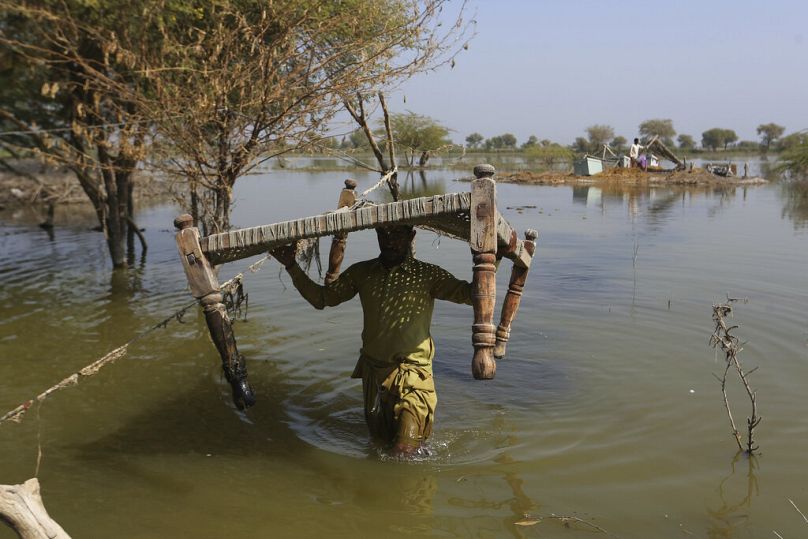
3. UN Secretary-General uses Oscar-winning film to make his point
The UN Secretary-General told the press conference at the launch of the report that the world needs climate action on all fronts. He referenced a recent Oscar-winning film calling for “everything everywhere all at once”.
Guterres has proposed that the G20 come together for something called the Climate Solidarity Pact. This agreement would see all big emitters make an extra effort to cut emissions. Wealthy countries are called upon to give funds to help emerging economies keep the 1.5℃ target alive.
He said that countries need to hit the “fast forward button” on their net zero deadlines.
“Specifically, leaders of developed countries must commit to reaching net zero as close as possible to 2040, the limit they should all aim to respect,” Guterres said.
“This can be done. Some have already set a target as early as 2035.”
Guterres’ Acceleration Agenda also includes actions like:
Net zero electricity generation by 2035 for developed countries
No more oil and gas licenses
“Every country must be part of the solution,” he said.
“Demanding others move first only ensures that humanity comes last.”
4. There is a clear way forward for climate resilience
The IPCC says that the solution lies in resilient development - finding ways to adapt to climate change or reduce greenhouse gas emissions that provide wider benefits.
“The greatest gains in wellbeing could come from prioritizing climate risk reduction for low-income and marginalised communities, including people living in informal settlements,” says Christopher Trisos, one of the report’s authors.
“Accelerated climate action will only come about if there is a many-fold increase in finance. Insufficient and misaligned finance is holding back progress.”
To be effective, the scientists say, these choices need to be rooted in our diverse values, world views and knowledge around the globe - including Indigenous knowledge. It would mean that these solutions are locally appropriate and socially acceptable.
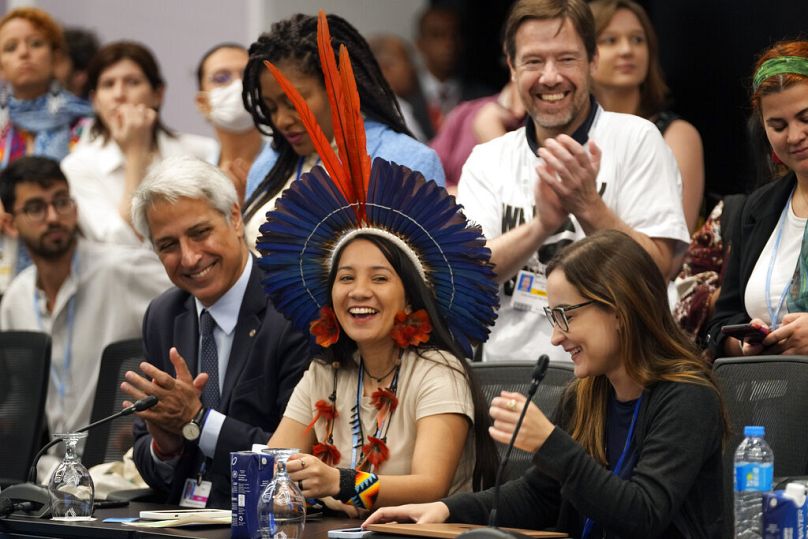
5. The money is there but it needs to be spent on the right solutions
We have the money we need to invest in rapidly reducing greenhouse gas emissions - if current barriers are removed, the IPCC says.
These barriers include information sharing, making finance available to those who need it and general international cooperation.
Governments are essential in bringing down these barriers as they can encourage investors and hand out public funding.
“Transformational changes are more likely to succeed where there is trust, where everyone works together to prioritise risk reduction, and where benefits and burdens are shared equitably,” Lee said.
We live in a diverse world in which everyone has different responsibilities and different opportunities to bring about change.Hoesung LeeIPCC Chair
Tried and tested policies which deliver deep emissions cuts and climate resilience need to be scaled up, according to the report. We need to share technology and know-how while making funding readily available.
“We live in a diverse world in which everyone has different responsibilities and different opportunities to bring about change,” Lee adds.
“Some can do a lot while others will need support to help them manage the change.”
Published: March 20, 2023

Wildfires are becoming a greater risk in many countries as the landscape dries.
Reading the latest international climate report can feel overwhelming. It describes how rising temperatures caused by increasing greenhouse gas emissions from human activities are having rapid, widespread effects on the weather, climate and ecosystems in every region of the planet, and it says the risks are escalating faster than scientists expected.
Global temperatures are now 1.1 degree Celsius (2 degrees Fahrenheit) warmer than at the start of the industrial era. Heat waves, storms, fires and floods are harming humans and ecosystems. Hundreds of species have disappeared from regions as temperatures rise, and climate change is causing irreversible changes to sea ice, oceans and glaciers. In some areas, it’s becoming harder to adapt to the changes.
Still, there are reasons for optimism – falling renewable energy costs are starting to transform the power sector, for example, and the use of electric vehicles is expanding. But the change isn’t happening fast enough, and the window for a smooth transition is closing fast, the Intergovernmental Panel on Climate Change report warns. To keep global warming below 1.5 C (2.7 F), it says global greenhouse gas emissions will have to drop 60% by 2035 compared with 2019 levels.
That’s 12 years from now.
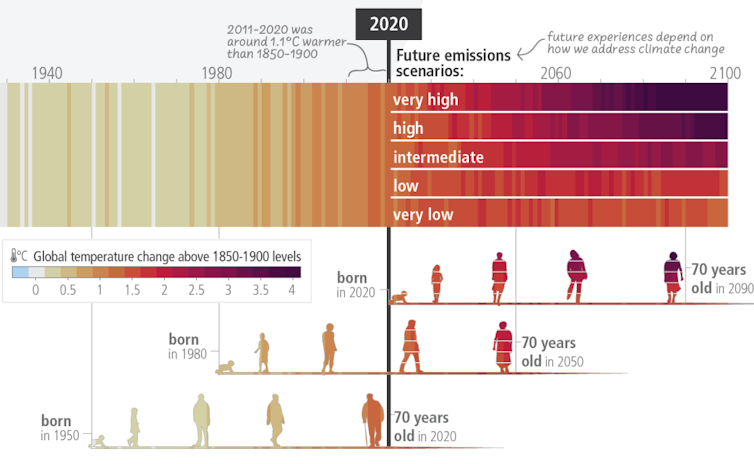
The extent to which current and future generations will experience a hotter world depends on choices made now and in the coming years. The scenarios show expected differences in temperature depending on how high emissions are going forward. IPCC sixth assessment report
In the new report, released March 20, 2023, the IPCC summarizes the findings from a series of reports written over the past eight years by hundreds of scientists who reviewed the latest evidence and research.
Here are four essential reads by some of the co-authors of those reports, each providing a different snapshot of the transformational changes underway.
1. More intense storms and flooding
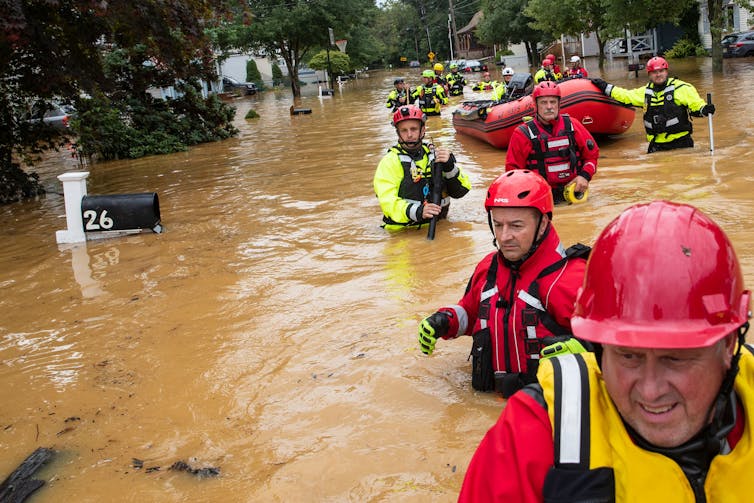
Many of the most shocking natural disasters of the past few years have involved intense rainfall and flooding.
In Europe, a storm in 2021 set off landslides and sent rivers rushing through villages that had stood for centuries. In 2022, about a third of Pakistan was underwater, and several U.S. communities were hit with extreme flash flooding.
The IPCC warns in the sixth assessment report that the water cycle will continue to intensify as the planet warms. That includes extreme monsoon rainfall, but also increasing drought, greater melting of mountain glaciers, decreasing snow cover and earlier snowmelt, wrote UMass-Lowell climate scientist Mathew Barlow, a co-author of the assessment report examining physical changes.
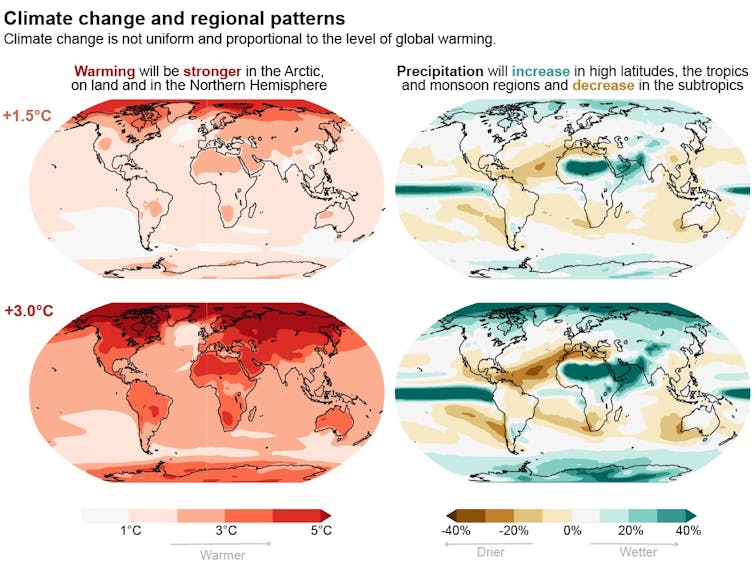
Annual average precipitation is projected to increase in many areas as the planet warms, particularly in the higher latitudes. IPCC sixth assessment report
“An intensifying water cycle means that both wet and dry extremes and the general variability of the water cycle will increase, although not uniformly around the globe,” Barlow wrote.
“Understanding this and other changes in the water cycle is important for more than preparing for disasters. Water is an essential resource for all ecosystems and human societies.”
Read more: The water cycle is intensifying as the climate warms, IPCC report warns – that means more intense storms and flooding
2. The longer the delay, the higher the cost
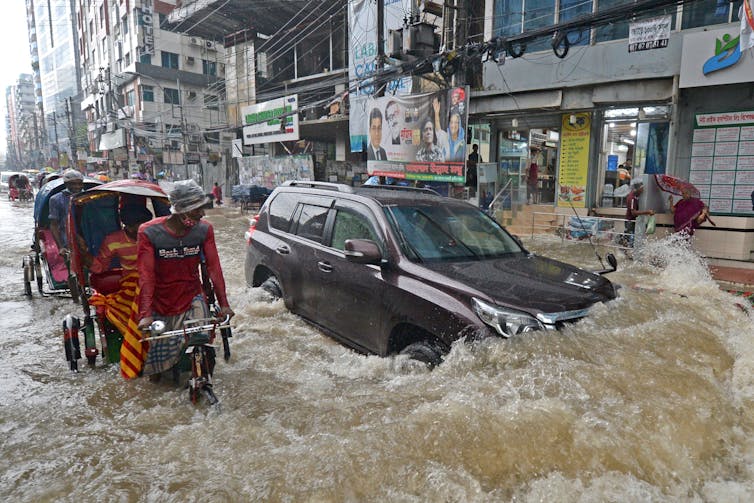
The IPCC stressed in its reports that human activities are unequivocally warming the planet and causing rapid changes in the atmosphere, oceans and icy regions of the world.
“Countries can either plan their transformations, or they can face the destructive, often chaotic transformations that will be imposed by the changing climate,” wrote Edward Carr, a Clark University scholar and co-author of the IPCC report focused on adaptation.
The longer countries wait to respond, the greater the damage and cost to contain it. One estimate from Columbia University put the cost of adaptation needed just for urban areas at between US$64 billion and $80 billion a year – and the cost of doing nothing at 10 times that level by mid-century.
“The IPCC assessment offers a stark choice,” Carr wrote. “Does humanity accept this disastrous status quo and the uncertain, unpleasant future it is leading toward, or does it grab the reins and choose a better future?”
Read more: Transformational change is coming to how people live on Earth, UN climate adaptation report warns: Which path will humanity choose?
3. Transportation is a good place to start
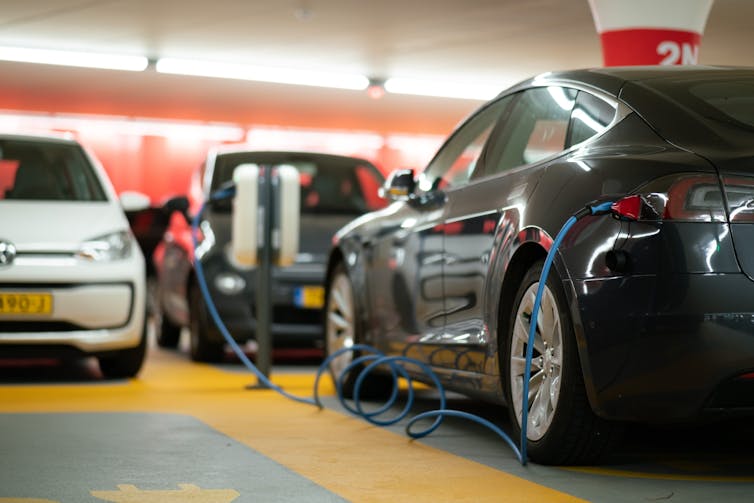
One crucial sector for reducing greenhouse gas emissions is transportation.
Cutting greenhouse gas emissions to net-zero by mid-century, a target considered necessary to keep global warming below 1.5 C, will require “a major, rapid rethinking of how people get around globally,” wrote Alan Jenn, a transportation scholar at the University of California Davis and co-author on the IPCC report dealing with mitigation.
There are positive signs. Battery costs for electric vehicles have fallen, making them increasingly affordable. In the U.S., the 2022 Inflation Reduction Act offers tax incentives that lower the costs for EV buyers and encourage companies to ramp up production. And several states are considering following California’s requirement that all new cars and light trucks be zero-emissions by 2035.
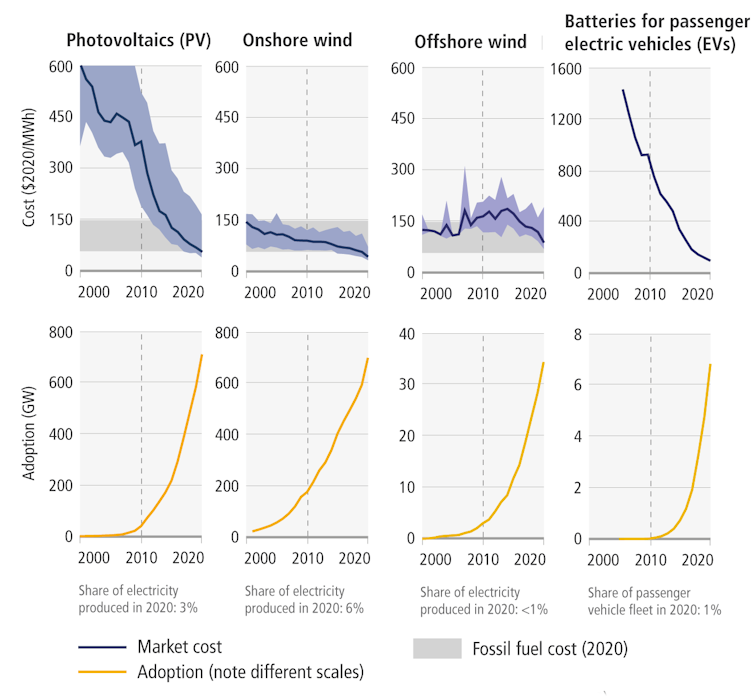
Costs have fallen for key forms of renewable energy and EV batteries, and adoption of these technologies is rising.
“Behavioral and other systemic changes will also be needed to cut greenhouse gas emissions dramatically from this sector,” Jenn wrote.
For example, many countries saw their transportation emissions drop during COVID-19 as more people were allowed to work from home. Bike sharing in urban areas, public transit-friendly cities and avoiding urban sprawl can help cut emissions even further. Aviation and shipping are more challenging to decarbonize, but efforts are underway.
He adds, however, that it’s important to remember that the effectiveness of electrifying transportation ultimately depends on cleaning up the electricity grid.
Read more: Revolutionary changes in transportation, from electric vehicles to ride sharing, could slow global warming – if they’re done right, IPCC says
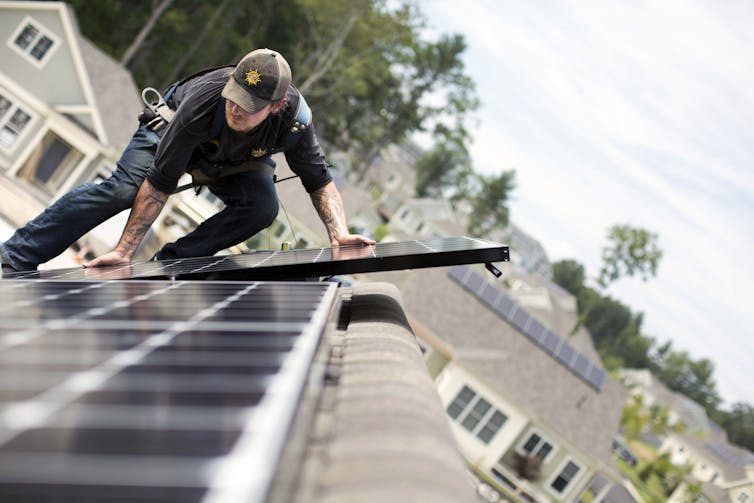
The IPCC reports discuss several other important steps to reduce greenhouse gas emissions, including shifting energy from fossil fuels to renewable sources, making buildings more energy efficient and improving food production, as well as ways to adapt to changes that can no longer be avoided.
There are reasons for optimism, wrote Robert Lempert and Elisabeth Gilmore, co-authors on the IPCC’s report focused on mitigation.
“For example, renewable energy is now generally less expensive than fossil fuels, so a shift to clean energy can often save money,” they wrote. Electric vehicle costs are falling. Communities and infrastructure can be redesigned to better manage natural hazards such as wildfires and storms. Corporate climate risk disclosures can help investors better recognize the hazards and push those companies to build resilience and reduce their climate impact.
“The problem is that these solutions aren’t being deployed fast enough,” Lempert and Gilmore wrote. “In addition to pushback from industries, people’s fear of change has helped maintain the status quo.” Meeting the challenge, they said, starts with embracing innovation and change.
Read more: Climate change will transform how we live, but these tech and policy experts see reason for optimism
Editor’s note: This story is a roundup of articles from The Conversation’s archives.
Environment + Climate Editor
Interviewed
Assistant Professional Researcher in Transportation, University of California, Davis
Professor and Director, International Development, Community, and Environment, Clark University
Associate Professor of Climate Change, Technology and Policy, Carleton University
Professor of Climate Science, UMass Lowell
Professor of Policy Analysis, Pardee RAND Graduate School





No comments:
Post a Comment